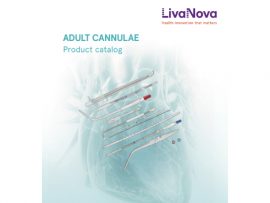Abstract Despite advancements in care, out-of-hospital cardiac arrest has a low survival rate. Extracorporeal cardiopulmonary resuscitation (ECPR) has shown improved outcomes in select cases, notably in the ARREST trial. However,..
Lire la suiteAbstract Background: The growing popularity of extracorporeal membrane oxygenation (ECMO) necessitates adequate education and training of the multidisciplinary teams caring for these medically complex patients. Simulation-based education (SBE) has been used..
Lire la suiteAbstract Background: End-stage heart failure remains a major global health challenge with high mortality. While heart transplantation is the gold-standard treatment, the scarcity of donor hearts necessitates alternative therapies. Left..
Lire la suiteAbstract Background Heparin-induced thrombocytopenia (HIT) is an immune-mediated platelet disorder caused by antibodies that target complexes of platelet factor 4 (PF4) and heparin. HIT has been characterized as a polyclonal..
Lire la suiteAbstract This meta-analysis aimed to compare short-term outcomes in patients undergoing minimally invasive cardiac surgery (MICS) using endoaortic balloon (EAB) and transthoracic aortic clamp (TAC) techniques. A comprehensive search of..
Lire la suiteAbstract The need for organs suitable for transplantation has continued to rise as need outweighs availability. Increased demand has driven innovation in the field. Over the past ten years, donation..
Lire la suiteAbstract BACKGROUND: Large language models (LLMs) are increasingly used in the medical field and have the potential to reduce workload and improve treatment procedures in clinical practice. This study evaluates..
Lire la suiteAbstract Purpose The optimal ventilation strategy in acute respiratory distress syndrome (ARDS) patients with veno-venous extracorporeal membrane oxygenation (VV-ECMO) remains unknown. We aimed to compare the effects of two ultra-protective..
Lire la suiteAbstract Uncertainties in norepinephrine dose reporting due to variable labeling practices secondary to salt formulation considerations have resulted in significant clinical and research challenges, potentially leading to impaired comparability across..
Lire la suiteAbstract Introduction Bleeding and thrombosis are major causes of morbidity and mortality in pediatric extracorporeal membrane oxygenation (ECMO), yet their evolving, time-dependent risks remain poorly defined. This study evaluated clinical..
Lire la suiteAbstract Background - Postoperative hemorrhage is a significant complication of cardiovascular surgery. Although autologous cell salvage is safe and effective for preserving patients' blood, its use in the postoperative context remains..
Lire la suiteAbstract Background (SCI) is a devastating complication of open descending thoracic (DTAA) and (TAAA). We evaluated the efficacy of spinal drain placement on spinal injury in DTAA/TAAA repair. Methods Adult patients..
Lire la suiteAbstract Background Development of Physiological Science (PS) Networks in the United Kingdom is guided by a 2023 strategic framework aimed at enhancing diagnostic services and patient care through collaboration and..
Lire la suiteAbstract Extubation of select neonatal and pediatric patients supported with extracorporeal membrane oxygenation (ECMO) may avoid ventilator-induced lung injury, decrease neurosedative exposure, and improve rehabilitation. A single-center retrospective cohort study..
Lire la suiteAbstract Background: Sepsis and septic shock are major contributors to global morbidity and mortality. The “cytokine storm,” a hyper-inflammatory response, plays a central role in sepsis pathophysiology, leading to multi-organ..
Lire la suiteAbstract Background The use of extracorporeal life support (ECLS) has expanded to include unique populations such as peripartum women. This systematic review aims to (1) quantify the number of cases..
Lire la suiteAt the time of publication of this guideline, the leading causes of maternal death for pregnant and peripartum patients include hemorrhage, infection, eclampsia, thromboembolism, and cardiac disease. Not only are these..
Lire la suiteAbstract Background Extracorporeal cardiopulmonary resuscitation (ECPR) is increasingly used for refractory cardiac arrest across the world, but its cost-effectiveness remains uncertain. We conducted this systematic review to assess the available..
Lire la suiteUniversity Conference Center Penn State Health Milton S. Hershey Medical Center and Penn State College of Medicine 30 Conference Dr. Hershey, PA 17033 Internet Live Course This training will be..
Lire la suiteIn modern surgical practice,managing perioperative blood loss typically exceeding 500ml to 1liter. is a critical factor impacting patient outcomes ,morbidity and resource mobilization. TYPES OF TRANSFUSION Allogeneic(Homologous) blood transfusion involves..
Lire la suiteAbstract Objectives The full extent of the COVID-19 pandemic’s impact during different phases of the pandemic and the recovery of cardiac surgical services in the United Kingdom have not been..
Lire la suiteAbstract Objectives Residual heparinization is a preventable cause of coagulopathy following cardiac surgery. The aim of this work was to assess the proportion of patients with residual heparinization following cardiac..
Lire la suiteAbstract Background Veno-venous extracorporeal membrane oxygenation (VV-ECMO) supports critically ill patients with respiratory failure. However, ECMO may induce systemic inflammation, hemolysis, and hemodilution, potentially resulting in endothelial activation and damage. Therefore,..
Lire la suiteAbstract Introduction Blood Stream Infections (BSI) occur in 3-35% of patients on ECMO (Extracorporeal membrane Oxygenation). With the increased use of ECMO since the COVID-19 pandemic, the magnitude of this..
Lire la suiteBlood transfusion and acute kidney injury after cardiac surgery: a retrospective observational study
Abstract Purpose Cardiac surgery-associated acute kidney injury (AKI) is linked to poor outcomes. An observational study from Copenhagen, Denmark identified perioperative red blood cell (RBC) transfusion as a modifiable risk..
Lire la suiteAbstract Background: Postoperative delirium (POD) is a neurocognitive syndrome affecting patients undergoing surgery. It is a frequent complication of coronary artery bypass grafting (CABG) and is associated with higher morbidity,..
Lire la suiteAbstract Venoarterial extracorporeal membrane oxygenation (VA-ECMO) often leads to left ventricular (LV) overload, particularly in patients with biventricular cardiogenic shock. This increased afterload can hinder cardiac muscle recovery and cause..
Lire la suiteAbstract Background Cardiac surgery involving cardiopulmonary bypass (CPB) serves as a clinical model of ischemia–reperfusion injury and endothelial dysfunction. Endothelial injury is often manifested clinically by vasoplegia and microcirculatory disturbances...
Lire la suiteAbstract Background: Extracorporeal membrane oxygenation (ECMO) requires systemic anticoagulation to prevent clotting, typically using unfractionated heparin (UFH). However, anticoagulation carries a bleeding risk, necessitating monitoring. Activated clotting time (ACT) is..
Lire la suiteAbstract To the Editor: Red blood cell (RBC) transfusion is commonly performed during on-pump cardiac surgery; however, excessive use may lead to adverse clinical outcomes and medical resources wastage.[] The call..
Lire la suite



















